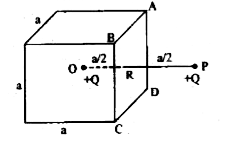A point object is placed on the axis of a thin convex lens of focal length 0.05 m at a distance of 0.2 m from the lens and its image is formed on the axis. If the object is now made to oscillate along the axis with a small amplitude of A cm, then what is the amplitude of oscillation of the image ?
[you many assume, 11+x=1−x, where x<<1]Solution in Bengali
4A9×10−2m
5A9×10−2m
A3×10−2m
A9×10−2m
Step by step video & image solution for A point object is placed on the axis of a thin convex lens of focal length 0.05 m at a distance of 0.2 m from the lens and its image is formed on the axis. If the object is now made to oscillate along the axis with a small amplitude of A cm, then what is the amplitude of oscillation of the image ? [you many assume, 1/(1+x) = 1-x, where x lt lt 1] by Physics experts to help you in doubts & scoring excellent marks in Class 12 exams.
Topper's Solved these Questions
- BOOK - WB JEE PREVIOUS YEAR PAPERCHAPTER - QUESTION PAPER 2019EXERCISE - PHYSICS (CATEGORY-II)4videos
QUESTION PAPER 2019
- BOOK - WB JEE PREVIOUS YEAR PAPERCHAPTER - QUESTION PAPER 2019EXERCISE - PHYSICS (CATEGORY -III)3videos
QUESTION PAPER 2019
- BOOK - WB JEE PREVIOUS YEAR PAPERCHAPTER - QUESTION PAPER 2018EXERCISE - PHYSICS40videos
QUESTION PAPER 2018
- BOOK - WB JEE PREVIOUS YEAR PAPERCHAPTER - QUESTION PAPER 2021 EXERCISE - PHYSICS (CATEGORY -II)6videos
QUESTION PAPER 2021
Similar Questions
Two identical blocks of ice move in opposite directions with equal speed and collide with each other. What will be the minimum speed required to make both the blocks melt completely, if the initial temperatures of the blocks were -8° C each ? (Specific heat of ice is 2100 Jkg−1K−1 and Latent heat of fusion of ice is 3.36×105Jkg−1)
01:38View SolutionA projectile thrown with an initial velocity of 10ms−1 at an angle a with the horizontal, has a range of 5 m . Taking g=10ms−2 and neglecting air resistance, what will be the estimated value of α ?
02:57View SolutionConsider a region in free space bounded by the surfaces of an imaginary cube having sides of length a as shown in the diagram. A charge +Q is placed at the centre O of the cube. P is such a point outside the cube that the line OP perpendicularly intersects the surface ABCD at R and also OR=a/2. A charge +Q is placed at point P also. What is the total electric flux through the five faces of the cube other than ABCD?
 02:27View Solution
02:27View SolutionTwo metal wires of identical dimensions are connected in series. If σ1 and σ2 are the electrical conductivities of the metal wires respectively, the effective conductivity of the combination is
05:31View SolutionAn object 50cm tall is placed on the principal axis of a convex lens. Its 20cm tall image is formed on the screen placed at a distance of 10cm from the lens. Calculate the focal length of the lens.
03:49View SolutionAn unsymmeterical double convex thin lens forms the image of a point object on its axis. Will the position of the image change if the lens is reversed ?
05:18View SolutionA thin linear object of size 1mm is kept along the principal axis of a convex lens of focal length 10cm. The object is at 15cm from the lens. The length of the image is:
04:29View SolutionThe principal axis of a thin equi-convex lens is the x-axis. The co-ordinate of a point object and its image are (– 20 cm, 1 mm) and (25 cm, 2 mm) respectively. Find the focal length of the lens.
View SolutionA point object is placed 20 cm left of a convex lens of focal length f = 5 cm (see the figure). The lens is made to oscillate with small amplitude A along the horizontal axis. The image of the object will also oscillate along the axis with
03:15View SolutionA particle executes a simple harmonic motion of amplitude 1.0 cm along the principle axis of a convex lens of focal length 12 cm. The mean position of oscillation is at 20 cm from the lens. Find the lens amplitude of oscillation of image of the particle. Does the image also execute simple harmonic motion ?
01:36View SolutionA point object is placed at a distance of 0.12 m on the axis of a convex lens of focal length 0.10 m. On the other side of the lens a convex mirror is placed at a distance of 0.10 m from the lens such that the image formed by the combination coincides with the object itself. What is the focal length of the convex mirror?
View SolutionAn unsymmetrical double convex thin lens forms the image of a point object on its axis. Will the position of the image change if the lens is reversed ?
04:55View SolutionAn unsymmeterical double convex thin lens forms the image of a point object on its axis. Will the position of the image change if the lens is reversed ?
04:29View SolutionAn unsymmetrical double convex thin lens forms the image of a point object on its axis will the position of the image change if the lens is reversed ?
11:16View SolutionA point object is placed at a distance of 12 cm on the axis of a convex lens of focal length 10 cm. On the other side of the lens, a convex mirror is placed at a distance of 10 cm from the lens such that the image formed by the combination coincides with the object itself. What is the focal length of convex mirror?
03:56View Solution

